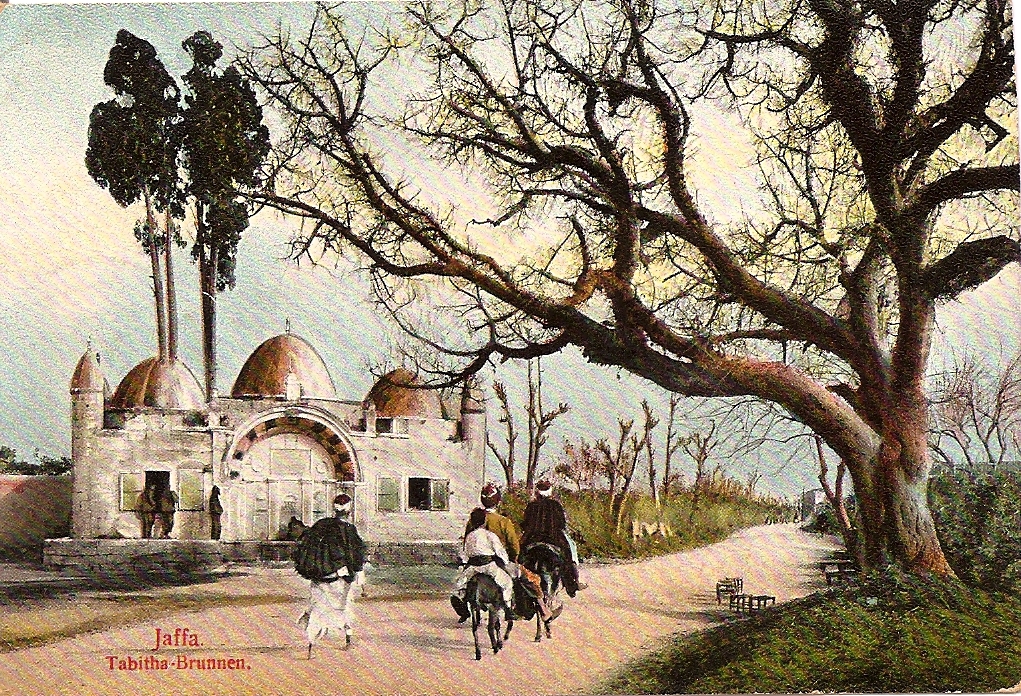Muhammad Abu-Nabbut on:
[Wikipedia]
[Google]
[Amazon]
Muhammad (Mehmet) Abu Nabbut Agha ( ar, محمد أبو نبوت) was the governor of
Archnet Digital Library. Abu-Nabbut possessed a similar character to Jezzar, becoming known for his ambitious construction and refurbishment projects in Jaffa and for his boundless cruelty as a ruler. He was also known as a just ruler who strove to improve Jaffa and better its inhabitants. Under his rule, the population and economic conditions of Jaffa and Gaza improved substantially. A number of legends surrounded Abu-Nabbut including one concerning his name. ''Abu-Nabbut'', meaning "Father of the Club" in
 During his tenure as governor Abu-Nabbut was responsible for a large number of building projects in Jaffa, including the completion of the fortifications of the city, the renovation of the Great Mosque, the erection of two sabils (public fountains), and the construction of cotton and wool markets.
During his tenure as governor Abu-Nabbut was responsible for a large number of building projects in Jaffa, including the completion of the fortifications of the city, the renovation of the Great Mosque, the erection of two sabils (public fountains), and the construction of cotton and wool markets.
 During his tenure as governor, in 1812, Abu-Nabbut ordered the construction of the
During his tenure as governor, in 1812, Abu-Nabbut ordered the construction of the
p.382
*Irby, Charles Leonard, James Mangles, Henrich Steffens (1852),
Travels in Egypt and Nubia, Syria, and the Holy Land: including a journey round the Dead Sea, and through the country east of the Jordan
' Published by J. Murray, 150 pages
Jaffa
Jaffa, in Hebrew Yafo ( he, יָפוֹ, ) and in Arabic Yafa ( ar, يَافَا) and also called Japho or Joppa, the southern and oldest part of Tel Aviv-Yafo, is an ancient port city in Israel. Jaffa is known for its association with the b ...
and Gaza in the early 19th century on behalf of the Ottoman Empire
The Ottoman Empire, * ; is an archaic version. The definite article forms and were synonymous * and el, Оθωμανική Αυτοκρατορία, Othōmanikē Avtokratoria, label=none * info page on book at Martin Luther University) ...
, from 1807 to 1818, as well as the governor of Thessaloniki
Thessaloniki (; el, Θεσσαλονίκη, , also known as Thessalonica (), Saloniki, or Salonica (), is the second-largest city in Greece, with over one million inhabitants in its Thessaloniki metropolitan area, metropolitan area, and the capi ...
from 1819 to 1827 during the Greek War of Independence
The Greek War of Independence, also known as the Greek Revolution or the Greek Revolution of 1821, was a successful war of independence by Greek revolutionaries against the Ottoman Empire between 1821 and 1829. The Greeks were later assisted by ...
.
Biography
Born Christian in the Balkans, Abu Nabbut converted to Islam and started his military and political career as an officer in thejanissary
A Janissary ( ota, یڭیچری, yeŋiçeri, , ) was a member of the elite infantry units that formed the Ottoman Sultan's household troops and the first modern standing army in Europe. The corps was most likely established under sultan Orhan ( ...
corps A few years after Jezzar's death in 1804, he was appointed by Jezzar's heir, Sulayman Pasha, as governor of the districts of Jaffa and Gaza.Al-Mahmudiyya MosqueArchnet Digital Library. Abu-Nabbut possessed a similar character to Jezzar, becoming known for his ambitious construction and refurbishment projects in Jaffa and for his boundless cruelty as a ruler. He was also known as a just ruler who strove to improve Jaffa and better its inhabitants. Under his rule, the population and economic conditions of Jaffa and Gaza improved substantially. A number of legends surrounded Abu-Nabbut including one concerning his name. ''Abu-Nabbut'', meaning "Father of the Club" in
Arabic
Arabic (, ' ; , ' or ) is a Semitic languages, Semitic language spoken primarily across the Arab world.Semitic languages: an international handbook / edited by Stefan Weninger; in collaboration with Geoffrey Khan, Michael P. Streck, Janet C ...
, supposedly was attributed to him from his habit of roaming the streets of Jaffa with a club, beating anyone who disobeyed his orders. The English traveller Charles Leonard Irby, who passed through Jaffa in 1817, observed that while his formal name was "Mohammed Aga", he was referred to as "Abou Nabout"; "the master of the mace or stick". Another local Palestinian
Palestinians ( ar, الفلسطينيون, ; he, פָלַסְטִינִים, ) or Palestinian people ( ar, الشعب الفلسطيني, label=none, ), also referred to as Palestinian Arabs ( ar, الفلسطينيين العرب, label=non ...
legend tells of how Abu-Nabbut was locked out of Jaffa after leaving the city to walk through the nearby orchards. When he demanded the gate be opened for him, the guard refused because he did not believe it was Abu-Nabbut waiting outside. After repeated calls, Abu-Nabbut was allowed entry. The next morning he summoned all of Jaffa's inhabitants and proclaimed "Cursed be the man, and cursed his father, who joins himself to a man of Jaffa." He ordered that this to be engraved on his well along the Jaffa Road
Jaffa Road ( he, רחוב יפו, Rehov Yaffo; ar, شارع يافا) is one of the longest and oldest major streets in Jerusalem. It crosses the city from east to west, from the Old City walls to downtown Jerusalem, the western portal of Jer ...
.
When Sulayman Pasha of Acre fell ill in 1818, Abu Nabbut apparently made moves to become his successor as governor of Acre. However, this did not suit Sulayman Pasha's influential financial advisor, Haim Farhi
Haim Farhi ( he, חיים פרחי}, ; ar, حيم فارحي, also known as Haim "El Mu'allim" ar, المعلم lit. "The Teacher"), (1760 – August 21, 1820) was an adviser to the governors of the Galilee in the days of the Ottoman Empire. A ...
, who favoured his young protégé Abdullah Pasha, believing that Abdullah would be more easy to control. Farhi therefore convinced Sulayman Pasha in the summer of 1818 to move against Abu Nabbut. Abu Nabbut was hence removed from Jaffa through an internal coup. This earned Farhi the eternal enmity of Abu Nabbut, who after his removal from Jaffa went to Istanbul
Istanbul ( , ; tr, İstanbul ), formerly known as Constantinople ( grc-gre, Κωνσταντινούπολις; la, Constantinopolis), is the List of largest cities and towns in Turkey, largest city in Turkey, serving as the country's economic, ...
, "where he could intrigue" against Farhi.
Between 1819 and 1827 Abu-Nabbut again served as a governor, first at Selanik
Thessaloniki (; el, Θεσσαλονίκη, , also known as Thessalonica (), Saloniki, or Salonica (), is the second-largest city in Greece, with over one million inhabitants in its Thessaloniki metropolitan area, metropolitan area, and the capi ...
, then at Diyarbakir.
After inquiries in Jaffa in the 1870s, Clermont-Ganneau
Charles Simon Clermont-Ganneau (19 February 1846 – 15 February 1923) was a noted French Orientalist and archaeologist.
Biography
Clermont-Ganneau was born in Paris, the son of Simon Ganneau, a sculptor and mystic who died in 1851 when Cler ...
found that the tomb of "the legendary Abu Nabbut" was located near the Sebil Abu Nabbut in Jaffa. This tomb survived at least until 1950, but it has now disappeared.
Buildings
 During his tenure as governor Abu-Nabbut was responsible for a large number of building projects in Jaffa, including the completion of the fortifications of the city, the renovation of the Great Mosque, the erection of two sabils (public fountains), and the construction of cotton and wool markets.
During his tenure as governor Abu-Nabbut was responsible for a large number of building projects in Jaffa, including the completion of the fortifications of the city, the renovation of the Great Mosque, the erection of two sabils (public fountains), and the construction of cotton and wool markets.
Fortifications
The French sacking of the city after theSiege of Jaffa
The siege of Jaffa was a military engagement between the French army under Napoleon Bonaparte and Ottoman forces under Ahmed al-Jazzar. On the 3 of March, 1799, the French laid siege to the city of Jaffa, which was under Ottoman control. It wa ...
in 1799 proved the inadequacy of the city walls, and when the city was returned to Ottoman control in 1800, Turkish and British engineers began to rebuild the fortifications. This task was completed under Abu-Nabbut from 1810 and onwards. Abu Nabbut added a monumental eastern gate crowned with three cupolas. The fortifications were specially designed to cope with European artillery and possessed thick walls, with substantial corner bastions, capable of supporting large cannon
A cannon is a large- caliber gun classified as a type of artillery, which usually launches a projectile using explosive chemical propellant. Gunpowder ("black powder") was the primary propellant before the invention of smokeless powder ...
s. Similar fortifications have survived at Acre
The acre is a unit of land area used in the imperial
Imperial is that which relates to an empire, emperor, or imperialism.
Imperial or The Imperial may also refer to:
Places
United States
* Imperial, California
* Imperial, Missouri
* Imp ...
. However, later in the nineteenth century the political situation had changed, and Abu-Nabbut's fortifications were no longer needed. By 1888 the dismantling process was complete and the moat
A moat is a deep, broad ditch, either dry or filled with water, that is dug and surrounds a castle, fortification, building or town, historically to provide it with a preliminary line of defence. In some places moats evolved into more extensive ...
was entirely filled in. Today, only two gateways and a short section of Abu-Nabbut's wall remains.
Mahmoudiya Mosque
 During his tenure as governor, in 1812, Abu-Nabbut ordered the construction of the
During his tenure as governor, in 1812, Abu-Nabbut ordered the construction of the Mahmoudiya Mosque
The Mahmoudiya Mosque ( ar, جامع المحمودية, he, מסגד מחמודיה) is the largest and most significant mosque in Jaffa, now part of the larger city of Tel Aviv. It is composed of a complex of buildings arranged around two large ...
which today is the largest mosque in Jaffa.
Sabil Abu Nabbut
Above the columns on the west side of the building is a plaque commemorating the construction of the sabil in 1236 H.Petersen, 2002, p. 170-172Palestinian villages
The inhabitants ofal-Jiyya
al-Jiyya ( ar, الجية, also transliterated Algie) was a Palestinian village that was depopulated during the 1948 Arab-Israeli War. Located 19 kilometers northeast of Gaza City, according to a 1945 census, the village had a population of 1,230. ...
reported that their village had been ruined at one point and then rebuilt by Abu Nabbut.Khalidi, 1992, p.114
See also
*Lady Hester Stanhope
Lady Hester Lucy Stanhope (12 March 1776 – 23 June 1839) was a British aristocrat, adventurer, antiquarian, and one of the most famous travellers of her age. Her archaeological excavation of Ashkelon in 1815 is considered the first t ...
References
Bibliography
* Cited in Petersen, (2001). *p.382
*Irby, Charles Leonard, James Mangles, Henrich Steffens (1852),
Travels in Egypt and Nubia, Syria, and the Holy Land: including a journey round the Dead Sea, and through the country east of the Jordan
' Published by J. Murray, 150 pages